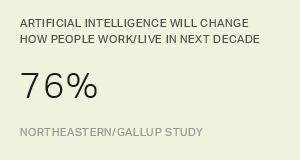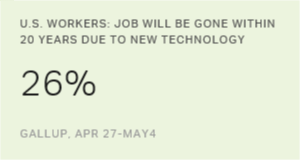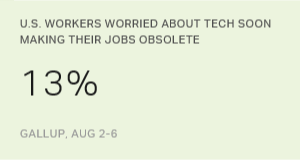Story Highlights
- 23% of employed Americans worry they will lose their jobs to AI
- Fear of job loss varies by education
- Manufacturing and construction sectors seen as most vulnerable
WASHINGTON, D.C. -- Nearly three in four working Americans (73%) say the rising use of artificial intelligence (AI) will eliminate more jobs than it creates across the country. However, a far smaller percentage of these workers (23%) say they are "very" or "somewhat" worried that they will lose their own jobs to this new technology.
| Very/Somewhat worried | Not too/Not at all worried | |||||||||||||||||||||||||||||||||||||||||||||||||||||||||||||||||||||||||||||||||||||||||||||||||||
|---|---|---|---|---|---|---|---|---|---|---|---|---|---|---|---|---|---|---|---|---|---|---|---|---|---|---|---|---|---|---|---|---|---|---|---|---|---|---|---|---|---|---|---|---|---|---|---|---|---|---|---|---|---|---|---|---|---|---|---|---|---|---|---|---|---|---|---|---|---|---|---|---|---|---|---|---|---|---|---|---|---|---|---|---|---|---|---|---|---|---|---|---|---|---|---|---|---|---|---|---|
| % | % | |||||||||||||||||||||||||||||||||||||||||||||||||||||||||||||||||||||||||||||||||||||||||||||||||||
| U.S. workers overall | 23 | 77 | ||||||||||||||||||||||||||||||||||||||||||||||||||||||||||||||||||||||||||||||||||||||||||||||||||
| Age | ||||||||||||||||||||||||||||||||||||||||||||||||||||||||||||||||||||||||||||||||||||||||||||||||||||
| 18 to 35 | 25 | 76 | ||||||||||||||||||||||||||||||||||||||||||||||||||||||||||||||||||||||||||||||||||||||||||||||||||
| 36 to 50 | 21 | 79 | ||||||||||||||||||||||||||||||||||||||||||||||||||||||||||||||||||||||||||||||||||||||||||||||||||
| 51 to 65 | 27 | 74 | ||||||||||||||||||||||||||||||||||||||||||||||||||||||||||||||||||||||||||||||||||||||||||||||||||
| Education | ||||||||||||||||||||||||||||||||||||||||||||||||||||||||||||||||||||||||||||||||||||||||||||||||||||
| Less than a bachelor's degree | 28 | 72 | ||||||||||||||||||||||||||||||||||||||||||||||||||||||||||||||||||||||||||||||||||||||||||||||||||
| Bachelor's degree or higher | 15 | 85 | ||||||||||||||||||||||||||||||||||||||||||||||||||||||||||||||||||||||||||||||||||||||||||||||||||
| Job type | ||||||||||||||||||||||||||||||||||||||||||||||||||||||||||||||||||||||||||||||||||||||||||||||||||||
| White collar | 19 | 81 | ||||||||||||||||||||||||||||||||||||||||||||||||||||||||||||||||||||||||||||||||||||||||||||||||||
| Blue collar | 26 | 74 | ||||||||||||||||||||||||||||||||||||||||||||||||||||||||||||||||||||||||||||||||||||||||||||||||||
| * Due to rounding, some percentages may add to more than 100%. | ||||||||||||||||||||||||||||||||||||||||||||||||||||||||||||||||||||||||||||||||||||||||||||||||||||
| Northeastern University/Â鶹´«Ã½AV survey, Sept. 15-Oct. 10, 2017 | ||||||||||||||||||||||||||||||||||||||||||||||||||||||||||||||||||||||||||||||||||||||||||||||||||||
These data come from a Northeastern University/Â鶹´«Ã½AV survey of Americans' attitudes toward AI and its effect on their lives and work. The mail survey of 3,297 U.S. adults, including 2,871 who are employed, was conducted Sept. 15-Oct. 10, 2017.
Employed Americans with less than a bachelor's degree are almost twice as likely to feel their jobs are at risk as are those with a four-year degree or more, 28% vs. 15%. Americans with less than a bachelor's degree are also less optimistic about the impact of AI in general and may feel that their own lower education levels leave them vulnerable to job loss attributable to the new technology.
There is a smaller gap in fear of job loss between employed Americans with blue-collar jobs (those working in industries largely composed of hourly wage earners) and those with white-collar positions (those working in largely salaried industries ), 26% vs. 19%, respectively. Similar to the gap in overall optimism seen in educational attainment, white-collar workers also tend to be more positive than blue-collar workers about the overall impact of AI.
Among American workers in their prime years of work -- those aged 18 to 65 -- worry varies modestly, ranging from 21% among those aged 36 to 50, to 27% among workers 51 to 65 years of age.
Construction and Manufacturing Seen as Most Vulnerable to AI
Americans who say AI will result in a net loss of jobs were asked to indicate which of a series of 12 economic sectors they believe would see jobs eliminated first by the new technology. More than six in 10 Americans (62%) who believe AI will result in a net job loss say the construction or manufacturing industries are the most likely to be eliminated by AI first. More than half also say the retail (55%) and transportation (52%) sectors are particularly vulnerable to replacement of jobs by new technology.

Americans who see AI adoption resulting in net job loss say the legal and public policy sector is the least vulnerable to replacement from this new technology, with 9% saying cuts in jobs related to AI will occur first in these fields. Additionally, jobs in the fields of arts, entertainment and sports, as well as those in community and social services, are seen as safe from AI -- with 15% and 16%, respectively, saying these positions will be eliminated first.
Implications
Although many Americans believe AI adoption will result in a net loss of jobs, about three in four are not worried about losing their own positions. This is reaffirmed in separate Â鶹´«Ã½AV research on the issue, which found that a similar level of Americans (72%) thought it was "not too likely" or "not likely at all" that they would lose their jobs to new technology in the next 20 years. However, anxiety about job loss to new technology is substantially higher than the 8% of employed Americans who say they are "very" or "fairly" likely to be laid off in the next year.
Americans who expect AI to lead to job losses in the U.S. identify the construction and manufacturing sectors as particularly vulnerable to new technology. This may be because of the long association of the introduction of robotics with job loss in the manufacturing sector. Additionally, retail may be seen as vulnerable because of the increasing popularity of online retail and changes such as self-checkout lines, which many Americans already use. Finally, transportation may stick out in Americans' minds because of extensive media coverage about self-driving vehicles.
Read the full Northeastern/Â鶹´«Ã½AV report "Optimism and Anxiety: Views on the Impact of Artificial Intelligence and Higher Education's Response."
Survey Methods
Results for the Northeastern University/Â鶹´«Ã½AV survey on artificial intelligence are based on surveys conducted by mail from Sept. 15-Oct. 10, 2017, with a random sample of 3,297 U.S. adults aged 18 and older. The survey package included an English and a Spanish survey to provide respondents with the flexibility to reply in their preferred language.
Â鶹´«Ã½AV selected the sample of U.S. residents using address-based sampling (ABS), a sampling technique used to select households from a list of all households on file with the United States Postal Service (USPS). Â鶹´«Ã½AV chooses respondents within the household at random based on which household member would have the next birthday. Â鶹´«Ã½AV used a series of postcard reminders to encourage participation in the survey.
Â鶹´«Ã½AV weighted the data to match national demographics of gender, age, education, race, Hispanic ethnicity, education and region.
All reported margins of sampling error include the computed design effects for weighting.
For results based on the total sample of 3,297 U.S. adults, the margin of sampling error is ±2 percentage points at the 95% confidence level.
For results based on the sample of 2,871 employed U.S. adults, the margin of sampling error is ±3 percentage points at the 95% confidence level.





